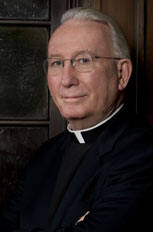In both cities, the pope will preside over outdoor Masses, with tens of thousands expected to attend. Tickets are limited and come with security restrictions. A call has gone out for priests to assist with Communion at these outdoor Masses and seminarians to serve as ushers. Cassocks will be required, however, which has occasioned a search in closets and trunks for long-neglected items of clerical clothing.
During his time in Washington, Benedict XVI will not only meet with the U.S. Catholic bishops but will also address a gathering of U.S. Catholic educational leaders at The Catholic University of America on April 17. There may be even more speculation, at least in certain quarters, about the content of the popes message on this occasion than about his address to the United Nations, where Benedict is likely to repudiate the use of violence in the name of religion.
The Vatican has presumably sought and received suggestions from people on this side of the Atlantic about what Benedict might say to his various U.S. audiences. I once had the opportunity to listen to Pope John Paul II address leaders of Catholic higher education in New Orleans in 1995 and noted significant changes from the proposed text that the Association of Catholic Colleges and Universities had sent to the Vatican. Dialogue within the church can take various forms.
The personal style of Benedict XVI is very different, of course, from that of his predecessor. When Karol Wojtyla became Pope John Paul II in 1978, the world knew very little about this Polish cardinal. I remember standing in St. Peters Square that October evening in 1978 when the announcement was made, Habemus papam...Carolum Cardinalem Wojtyla. The unfamiliar name prompted a seminarian in the crowd to declare, Its the Japanese cardinal. But then, after a quick perusal of the issue of LOsservatore Romano with pictures of all the cardinals in the conclave, he realized, There is no Japanese cardinal!
Over his long tenure (1978-2005), Pope John Paul II became a very familiar figure to the large crowds that greeted him on his visits to over 100 countries around the globe, but he was very much an unknown figure when he began his pontificate. In contrast, when Cardinal Joseph Ratzinger became Pope Benedict XVI three years ago, he was, if anything, too well known and his image as a disciplinarian, after a long tenure as head of the Congregation for the Doctrine of the Faith, was sharply defined in the popular imagination. But it has proven since to have been something of a caricature.
During the three years of his pontificate, Benedict XVI has returned to his lifelong vocation as a theologian and teacher. His two encyclicals have addressed the fundamental Christian virtues of love and hope with a generosity of spirit and depth of meaning that have enriched the understanding of Catholics and commanded the respect of others. The publication in September 2006 of Jesus of Nazareth, the first part of his projected life of Jesus, has been welcomed by believers across the spectrum of theological opinion as a summons to a renewed personal faith in the central figure of the New Testament.
On his first, and perhaps only, visit to the United States, Benedict XVI will not attempt to emulate the personal style of his charismatic predecessor. Joseph Ratzinger began his pontificate at a different stage of his life than Karol Wojtyla, who was 58 at the start of his. The fundamental Petrine ministry, of course, is to symbolize and support the unity of the church and the communion of the churches. But different popes have different styles, and I suspect that in the years remaining to him, Benedict will exercise that ministry in the style of the teacher and theologian he has always been.








